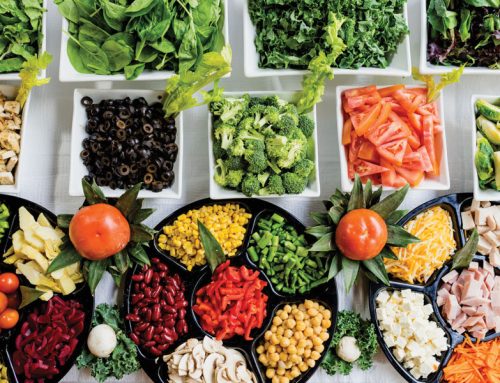Tangy, tingling, sour — sometimes that indescribable “fifth taste” known as umami — foods that have been fermented have unique health benefits, especially for people with diabetes. Fermentation is one of the oldest methods of preserving food. It’s what transforms milk into yogurt; cabbage into sauerkraut and the Korean dish kimchi; soybeans into miso; and alcohol into vinegar. But the best part is that research shows that these foods are good for your blood sugar. The acids in fermented foods — lactic and acetic acid — block carbohydrates from entering the blood and turning into blood sugar, reducing spikes. And these benefits can carry over to the next meal.
But that’s not all. Every culture has a long tradition of fermented and raw foods – foods that provide for healthy intestinal flora and decrease the load on your pancreas and liver. Fermented foods are less common in the typical Western diet but play a starring role in the diets of other cultures, especially Asia. Probiotics (friendly bacteria) in fermented foods help convert sugar into lactic acid for greater digestibility. They help stabilize blood sugar, improve gut flora, boost the immune system and are rich in essential vitamins – all of which are helpful in any Diabetes Healing Diet. Sadly, because of today’s industrial food model, these traditional foods have morphed into something unrecognizable. Corned beef is no longer raw and preserved with salt and spices. Cheese is made from devitalized pasteurized milk. Bread makers rarely use real fermented sourdough starters in their so-called sourdough loafs. And homemakers hardly ever soak their freshly ground whole wheat flour overnight in buttermilk to create the light and fluffy pancakes and biscuits we love to love. The modern equivalents of age-old fermented foods are nutritionally empty when compared to their historical counterparts. Take grains, for example. Did you know that traditional societies either soaked, sprouted, or fermented their grains prior to consuming them? While the reasons our ancestors practiced this level of grain preparation are debatable, we do know that sprouting, fermenting, and soaking grains can increase vitamin and mineral content availability by 300-500%.
Whatever happened to preserving food using lacto-fermentation? Before the modern era of hot water bath canning and vinegar brines, people used to preserve vegetables and fruits in cans and other air tight containers using lactic-acid fermentation. The lactic-acid caused the food to pleasantly sour (think: pickles), increased the vitamin & mineral content of the food, provided a rich source of valuable digestive enzymes, and preserved the food for months at a time. We need to get over our prejudices. Cooked and over-processed to the extreme, the average American diet lacks the vitamins, minerals and enzymes natural to fermented and raw foods. Compare this to traditional diets around the world where raw and fermented foods make up 60-80% of their food intake. While science debates the ins and outs of exactly why raw and fermented foods are so much healthier for us (living enzyme content? more available nutrients?), anecdotal evidence makes the benefits clear. 1. Lactobacilli aid digestion. The most common fermented products are fermented, or cultured, dairy products. Lacto-fermentation works through the action of friendly bacteria known as lactobacillus, which includes approximately 125 species under its genus. The most common strains are acidophilus and L. casei. Lactobacillus is found mostly in cultured milk products such as plain yogurt, kefir and buttermilk, as well as crème fraîche, sour cream and European-style cultured butter and cheese. Lactobacillus is also found in other fermented foods such as pickles, sauerkraut, umeboshi plums and kimchi as well as sourdough bread and beer. The recipe for fermented foods is generally quite simple: fresh vegetables, salt, pure water. And time. Sometimes whey, a by-product of the cheese-making process, is added for additional lactobacilli. 2. Fermented foods help with diabetic weight gain and complications. According to a study published in Natural News, fermented foods are lower on the glycemic index (GI) than non-fermented foods. This makes them helpful in preventing weight gain because they are low in carbohydrates and prevent blood sugar spikes.
The fermentation process is diabetic friendly as it ‘eats’ those sugars and starches that can raise our blood sugars. Fermentation at the very least makes foods more diabetic friendly. Individual foods should be tested to confirm expected affect on blood sugar levels.\n\n3. More benefits of fermented foods. The substantial levels of vitamin B found in fermented foods help with cell growth and metabolism. Vitamin C, a powerful antioxidant, helps boost the immune system and combat free radicals. Vitamin K helps prevent the atherosclerosis and heart disease that can develop in diabetics. Keep fermented food in your Diabetes Healing Pantry so you can add some sauerkraut to your salad or sandwich and/or eat some kimchi with your stir-fry. And don’t forget: one-quarter cup of plain yogurt a day helps chase diabetes away! People who start eating a diet high in raw fermented foods reverse the course of cancer, stop diabetes in its tracks, and notice an increased level of heart fitness. So, what are you waiting for? Photo courtesy of freedigitalphotos.net







